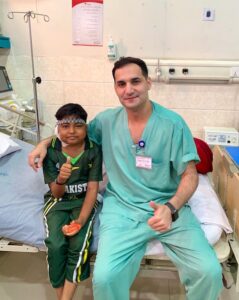 Attaulah Khan Niazi (King Edward Medical University, Lahore, Pakistan) documents the major challenges standing in the way of establishing minimally invasive cardiac surgery techniques in the developing world. Greater international cooperation is needed, if these techniques are going to take hold outside of the developed world, he writes.
Attaulah Khan Niazi (King Edward Medical University, Lahore, Pakistan) documents the major challenges standing in the way of establishing minimally invasive cardiac surgery techniques in the developing world. Greater international cooperation is needed, if these techniques are going to take hold outside of the developed world, he writes.
Living in a developing country and trying to treat structural heart disease in an endemic area for rheumatic fever is an ever-growing challenge. Pakistan is located in South Asia, an area that is home to at least one quarter of the world’s population, and as much as half of its population has suffered from under-nourishment or malnutrition. There is not only a huge patient load, but a lack of resources, trained staff and infrastructure.
The main bulk of valvular heart disease in the region still arises from rheumatic heart disease, and much of that is in a younger population, below 40 years of age, which tremendously affects the country’s workforce. Pakistan’s health system relies on subsidising major teaching hospitals or tertiary care centres without any comprehensive insurance coverage, which means that most patients have to pay for their treatment out of their own pocket. Many large cardiac centres cover bigger volumes of cardiac surgery workload, with 10 large cardiac centres covering almost 1,500 open heart surgeries per year, albeit with a higher wound infection rate, sternal dehiscence and extravagant antibiotic use.
As well as other important factors, including the disease pattern in our South Asian patient population, we have observed late surgical interventions, with poor prognosis due to late diagnosis, and a time delay between diagnosis and surgery. In addition, we have found a high rate of postoperative infection, leading to a prolonged hospital stay and extensive use of intravenous (IV) antibiotics.
 Minimally invasive cardiac surgery brings with it a major ray of hope for addressing some of these challenges in the form of swifter recovery time, reduced cost, and earlier return to work, as well as other benefits in kind for a young population.
Minimally invasive cardiac surgery brings with it a major ray of hope for addressing some of these challenges in the form of swifter recovery time, reduced cost, and earlier return to work, as well as other benefits in kind for a young population.
Efforts to establish minimally invasive surgical techniques are challenged by the small number of cardiac surgeons operating in Pakistan, with only 196 cardiac surgeons for a population of 240 million. Additionally, there is no structured training programme for local surgeons on new minimally invasive cardiac surgery techniques, and surgical team members have lacked the incentive and interest to participate due to low salaries and poor retention of highly trained medical personnel.
We also face the challenge of poor financial sustainability, the lack of a reliable medical record system, low quality equipment and maintenance, a lack of hospital infrastructure and capacity for new programmes, and relatively few research facilities. Alongside this, patients have poor levels of health and literacy resulting in difficulties with compliance with physician instructions or understanding of operative risk, compounded by low levels of patient follow-up. Outside of this, there is poor local governance and a lack of commitment to cardiac care from politicians, creating problems with the growth and expansion of minimally invasive cardiac surgery programmes.
From the outset our plan was to form a team comprising cardiovascular surgeons, interventional cardiologists, cardiovascular imaging specialists and cardiac anaesthesiologists to execute advanced cardiac surgery at our centre. The team played an important role in planning, supervising the purchase of new equipment (assembled locally), and developing a departmental policy for minimally invasive procedures and its financial aspects. We worked very closely with local industry to arrange onsite proctoring and invited international faculty to conduct workshops on innovated procedure and live case session.
Our aims are to minimise cost by decreasing hospital stay, to advance minimally invasive access approaches, minimise the use of antibiotics, and offer incentives to junior surgeons with a focus on a structured training programme of minimally invasive procedures.
Since the introduction in 2021 of a new national health insurance system in Pakistan—the Sehat Sahulat Program—our patients have been able to get standard treatment from any government and private sector provider, giving us all an equal chance to deliver. With this new standardised insurance system we are able to generate funds for these procedures, which gives us a greater opportunity to be able to sustain a structured minimally invasive cardiac surgery programme in this country.
We strongly recommend a collaborative effort from the international cardiovascular community, non-governmental organisations, local governments, and private benefactors to facilitate minimally invasive cardiac surgery in developing countries in order to improve surgical result in our centres and serve our people better.













